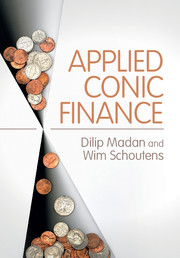Book contents
- Frontmatter
- Dedication
- Contents
- Preface
- Acknowledgements
- 1 Financial Mathematics Principles
- 2 Stochastic Processes and Financial Models
- 3 Numerical Techniques
- 4 Conic Finance
- 5 Conic Pricing
- 6 Applications of Conic Finance
- 7 Conic Portfolio Theory
- 8 Conic Hedging
- 9 Hedging Insurance Contracts
- 10 Option Positioning
- 11 Conic Trading
- References
- Index
1 - Financial Mathematics Principles
Published online by Cambridge University Press: 27 October 2016
- Frontmatter
- Dedication
- Contents
- Preface
- Acknowledgements
- 1 Financial Mathematics Principles
- 2 Stochastic Processes and Financial Models
- 3 Numerical Techniques
- 4 Conic Finance
- 5 Conic Pricing
- 6 Applications of Conic Finance
- 7 Conic Portfolio Theory
- 8 Conic Hedging
- 9 Hedging Insurance Contracts
- 10 Option Positioning
- 11 Conic Trading
- References
- Index
Summary
Financial Derivatives and Derivatives Markets
A financial derivative is a special type of financial contract whose value and payouts depend on the performance of a more fundamental underlying asset. One finds derivatives on the basis of all kinds of underlying entities, such as equity derivatives, whose performance is linked to the behaviour of underlying stock prices or stock indices; fixed income derivatives, whose payout depends on the level of interest rates; currency derivatives, that are connected with one or more FX exchange rates; derivatives on commodities which, for example, can depend on the (joint) evolution of oil, gas, gold, orange juice or any other commodity prices. Actually, they can come in all forms and on the basis of all kinds of underliers; sometimes even a combination of several underliers from different asset classes (hybrids).
Derivatives come into existence in modern economies and encourage price discovery in free markets with consequent price volatility. Often, good business planning requires some limited price stability. This can be (partially) provided by derivatives. One then shifts price risk to professionals better positioned to manage the oscillations. Derivatives can be used for many purposes. They can be used not only to mitigate price risk but also to speculate on it. Many contracts and structured products are implemented using derivatives. A sophisticated risk-management of a portfolio uses derivatives to hedge away as completely as possible all undesired exposure. Some capital instruments even have derivative features and can be seen essentially as cash flows being made contingent on the resolution of future uncertainties.
Derivatives are traded on exchanges (like the CBOE) or over the counter (OTC). Derivatives traded on exchanges are typically standardized; OTC derivatives are tailor made. You can compare it with a clothes collection that comes in one design and is available in standardized sizes (XS, S,M, L,XL, …) and colours. These you find in retail shops (compare with exchanges). If, however, you desire a different design, which fits your frame and specific body form and is printed in your preferred (non-standard) colour, you have to go to a tailor and have it custom made (compare with OTC).
- Type
- Chapter
- Information
- Applied Conic Finance , pp. 1 - 20Publisher: Cambridge University PressPrint publication year: 2016
- 1
- Cited by



